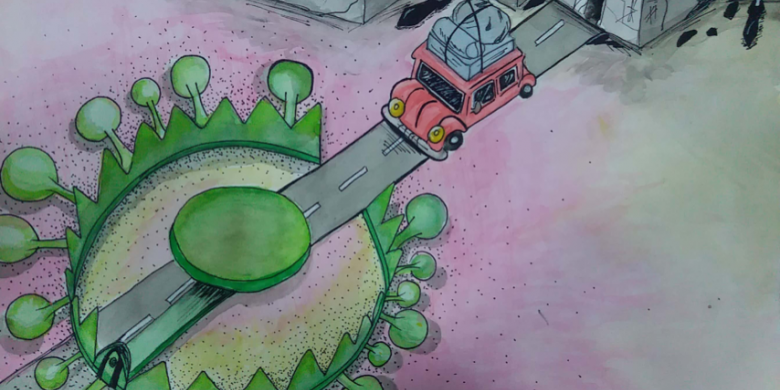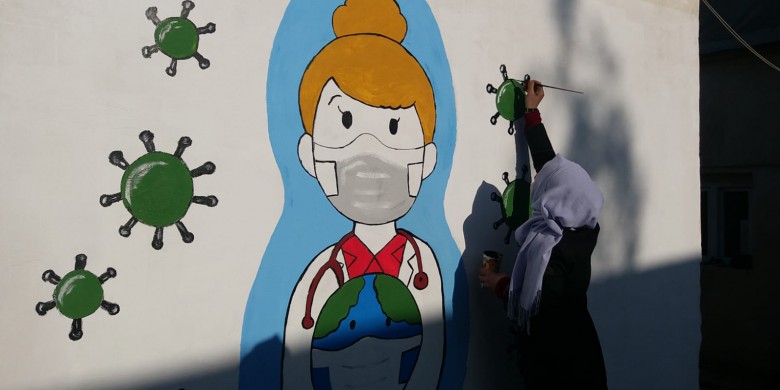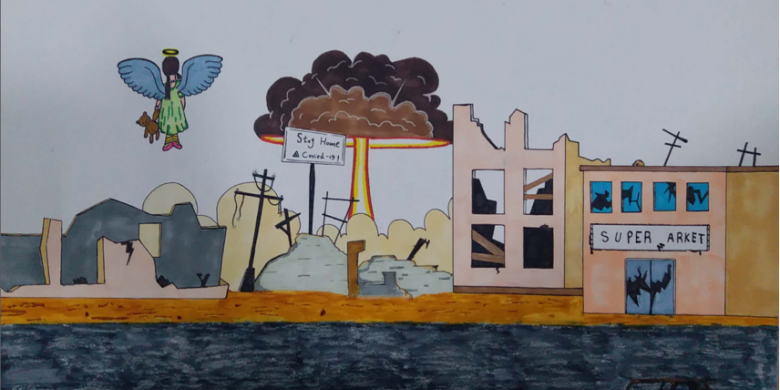
Art as a tool for local peace
“Local Voices at a Crossroads” is an article series in which local actors of everyday peace share their insights into the fragilities and resilience of their societies in the face of conflict. Grassroots societies lie at the crossroads between local realities and national peacebuilding policies and practices. The series therefore aims to accelerate action at the local level by strengthening the voices of civil society at the policy level. “Local Voices at a Crossroads” is hosted by the Civil Society Platform for Peacebuilding and Statebuilding (CSPPS) and emerged from a collaboration with the Political Settlements Research Programme (PSRP*), based at the University of Edinburgh.
With this contribution to “Local Voices at the Crossroads’, we open a series of three stories looking at the role of youth in local peacemaking in Syrian opposition-held area in the northwest of the country. They are students, artists, civil society members, and entrepreneurs of peace in a country at war for more than a decade. Most of them are too young to have a clear recollection of Syria before the conflict, but they are all committed to building a future free from violence and suffering.
In preparation for this blog, we spoke extensively with ten young artists who form the Blue Team (Fariq Azraq in Arabic) - a group located in Azaz, roughly 30 kilometres northwest of Aleppo. We asked them to reflect on the challenges and opportunities for art to contribute to peace in Syria. While protracted violence has pushed some to pick up arms, these young artists picked up pencils and brushes and put their creativity at the service of their communities.

Art to escape and resist
The young men and women we met in Syrian opposition-held areas did not join the massive exodus of Syrian artists at the outset of the conflict in 2011; most of them were under 10 years old. They are indeed artists born out of the war. Over the years, they witnessed the progressive disappearance of creativity and culture as a result of protracted violence. For the past decade, the politics of the Syrian conflict as well as the material and human destruction have been well-documented. Yet, statistics and complex analysis often overshadowed the experiences and suffering of the Syrian people. It is to escape their suffering and traumatic experiences that these young Syrians started drawing.
Mohammed*, 22 years old, recorded: “I was injured several times during the siege of Eastern Ghouta [in the northeast of Damascus]; my house was bombed more than three times. At that time, drawing was a hobby I resorted to when I was bored. After I was displaced in 2018, I started using my art more often as a tool of psychological support to heal my trauma”. Leila, a 16-year-old young woman displaced from Saraqib in Idlib governorate, offered a similar account: “I used to think that only physical distance would protect me and my family from violence. When we were forced to leave my city, I felt like my world was collapsing and my life only revolved around war and dire living conditions. But these negative thoughts slowly faded away when I started drawing”.
For the young artists we met, art provided a safe haven, a window out of the conflict and a way to escape the atrocities of war. They all first used art for themselves, as a self-healing practice that helps “discharge negative energies”. But their talent quickly became a form of resilience and resistance that they now use to transform traumatic experiences into a purpose of public interest.
"The power of art lies in its ability to vehiculate complex feelings and messages simply and eloquently. By clarifying identities, worldviews, and experiences, art fosters mutual understanding and empathy; it can help mitigate conflicts and rebuild the social fabric."

Art to heal and influence
The young artists feel invested in a mission and are mindful of their responsibilities in Syria. On the one hand, art gives the opportunity to leave a timeless account of the many sufferings Syrians experienced during the war, in the hope that future generations will prevent history from repeating itself. On the other, the young artists believe that art can contribute to the reconstruction of society. As explained by 16-year-old Khaled, “art is about delving in the heart of our identities and sufferings and re-introducing ourselves and our feelings to the community in a new form, so that new solutions can be offered”. Khaled’s words are echoed by his fellow artists who witnessed how conflicts often arise from misunderstanding or lack of knowledge about others. The fractures of the Syrian society have been politicised to fuel the war so that Syria is currently mired in a nest of conflicts which are often rooted at the local level. For 16-year-old Mumtaz, who recently relocated to the northern countryside of Aleppo, the power of art lies in its ability to vehiculate complex feelings and messages simply and eloquently. By clarifying identities, worldviews, and experiences, art fosters mutual understanding and empathy; it can help mitigate conflicts and rebuild the social fabric. The young artists are aware that it will take more than drawings to bring peace back to Syria. But as argued by 18-year-old Nour, “Art is an instrument of peace amid the flames of war. It may not extinguish the burning fire, but it relieves the pain of the wound”.
Beyond grassroots communities, some of the young artists we talked to believe that their art can influence politicians and decision-makers. This is the case of Leila: “Art is knowledge. When we visualise and share knowledge via art exhibitions or graffiti on the wall of our city, we force interactions with other communities, including politicians. As such, we can be real influencers”. Similarly, Hamad, who recently started drawing at the age of 21, believes that art contributes to shaping public opinion which, in turn, can pressure politicians to implement political reform and promote peace efforts. For others, the power of their art lies precisely in the fact that it escapes political considerations and focuses on more universal themes such as human suffering. Whether their talent can bridge the divides between elements of Syrian society, all young artists agree on the fact that art is part of a bottom-up process whereby inner peace at the individual level can spread across communities and foster social peace. This includes reviving Syrian culture and spreading positive energies and colours in the lives of Syrian people.
“Art is an instrument of peace amid the flames of war. It may not extinguish the burning fire, but it relieves the pain of the wound”.
Art to raise local voices
Over the past ten years, Syrians have been silenced and excluded from the negotiations on the future of their country. Art is a reaction to this disenfranchisement; it is used by artists to reclaim their identity and regain their voice. Leila voiced the frustration of millions of Syrians: “We are depicted as terrorists through mainstream media because we live in opposition-held areas. But we are normal people. We are painters, musicians, poets, and writers.” Hence the urge for the young artists to send a strong message to the world – Syrians are suffering from the conflict – in a universal language that transcends all linguistic and cultural barriers. Yet, Hamad emphasised that the suffering should not overshadow an equally important message: life continues despite daily difficulties, and hope and resilience prevail in Syria.

Opposition-held areas in the northern countryside of Aleppo have enjoyed relative stability over the past year, which has allowed young artists to organise several local exhibitions and participate in training offered by community centres with the support of civil society. They feel somehow privileged and responsible, because their art enjoys a good amount of credibility and is proof of their persistence and strength in the face of conflict. In contrast, artists living in the areas controlled by the Syrian regime face strong censorship and exiled artists may be perceived as disconnected from the realities inside Syria. But there are many challenges to being an artist in Syrian opposition-held areas. Art materials are scarce and costly; artists must sometimes travel a hundred kilometres to buy good-quality brushes and colours. Moreover, art is often considered a hobby or even a waste of time in a place where securing livelihoods remains challenging. The art market is inexistent in northwest Syria, so local artists cannot use their talent to contribute to the living expenses of their families. While the young artists noted signs of greater open-mindedness at the society level and support from education institutions such as the Free University of Aleppo, they also pointed to criticisms and prejudices against their difference as artists. But these numerous challenges cannot seem to shake the resolve of the young artists: “We are the children of war and we are ready to decorate our world with our paintings and to spread our colours across borders. The world needs to know that we are here”.
* All names have been modified
_________________________________________________
Raise your voice! Contact us to share your or others’ experiences of vulnerability and resilience to conflict and efforts for peace.
Article written by Juline Beaujouan, Eyas Ghreiz and Abdulah El hafi
Juline Beaujouan is a Research Associate with the Political Settlements Research Programme (PSRP), based at the University of Edinburgh, where she researches local conflict management and trust-building in Lebanon, Iraq and Syria. Juline received her Ph.D from Durham University where she was awarded the al-Sabah doctoral fellowship and acted as a member of the AHRC’s Open World Research Initiative (OWRI). Juline is the co-editor and contributor to the volume Syrian Crisis, Syrian Refugees - Voices from Jordan and Lebanon, and co-author of Islam, IS and the Fragmented State: The Challenges of Political Islam in the MENA Region.
Eyas Ghreiz is a researcher and consultant in areas of human rights and development. Ghreiz is also a Master student in International Development, specialising in conflict, security and development, at the University of Birmingham, UK. Ghreiz has over eight years of working experience with international NGOs, and UN bodies in Jordan, Syria, Turkey and Yemen. He has published several articles in both Arabic and English and contributed to the book Syrian Crisis, Syrian Refugees: Voices from Jordan and Lebanon, published by Palgrave Macmillan in both English and Turkish, and will be published in Arabic soon.
Abdulah El hafi co-founded and managed the Unified Relief Office in Eastern Ghouta and sat on the board of directors for two years. In 2013, he was a founding member of the Civil Defense in Eastern Ghouta in Rif Damascus. From 2014 to 2019, Abdulah worked as a coordinator and field manager for several programs funded by the British DFID and USAID. He also delivers trainings in the field of good governance and capacity building for several local organizations, teams and councils in Rif Damascus, Idlib, and northern Aleppo governorates. Currently, Abdulah is working as the manager of the Local Administrative Councils Unit (LACU) Syria Office.
*The Political Settlements Research Programme is a partner of the Covid Collective. The Collective brings together the expertise of UK and Southern-based research partner organisations and offers a rapid social science research response to inform decision-making on some of the most pressing Covid-19 related development challenges. The PSRP and Covid Collective are supported by the UK FCDO.
